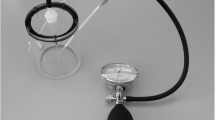Summary
The construction of a propulsion chamber system is simplified by separating the different eelements of its functions. For injections of the propulsive fluid the coiling chamber is bypassed, leaving its contents untouched. The diameter of the coaxial system is reduced by minimizing the space between the two catheters. Consequently the puncture site becomes small (a balloon-catheter may be introduced through a 16 G catheter needle) allowing punctures proximal to lesions (e.g. puncture of the axillary a. or the carotid a.) and thus shortening the length of the coaxial catheter system. The risk of thrombus formation diminishes and renders heparinization dispensable. Control angiographies are separated from the coaxial system.
Similar content being viewed by others
References
Dotter CT, Straube KR (1962) Flow-guided cardiac catheterization. Am J Roentgenol 88:27–30
Luessenhop AJ, Velasquez AC (1964) Observations on the tolerance of the intracranial arteries to catheterization. J Neurosurg 21:85–91
Tatoolas CJ (1971) A simplified technique for the percutaneous introduction of silicone elastomer catheters. Surg Gynecol Obstet 133:105–106
Fogarty TJ, Schneider JM (1971) Technique for placement of silicone elastomer catheters for CVP hyperalimentation and wedge pressure (abstract). J Ass Adv Med Instr 5:115
Dotter CT, Rosch J, Lakin RC, Pegg JE (1972) Injectable flow-guided coaxial catheters for selective angiography and controlled vascular occlusion. Radiology 104:421–423
Picard L, Moret J, Lepoire J (1984) Endovascular treatment of intracerebral arteriovenous angiomas. J Neuroradiol 11:9–28
Kerber CW (1976) Balloon catheter with a calibrated leak. Radiology 120:547–550
Pevsner PH, Doppman JL (1980) Therapeutic embolization with a microballoon catheter system. AJR 134:949–958
Debrun G, Vinuela F, Fox A, Drake CG (1982) Embolization of cerebral arteriovenous malformations with bucrylate. J Neurosurg 56:615–627
White RI Jr, Kaufman SL, Barth KH, DeCaprio V, Strandbert JD (1979) Embolotherapy with detachable silicone balloons: technique and clinical results. Radiology 131:619–627
Norman D, Newton H, Edwards S, De Caprio V (1983) Carotid-cavernous fistula: closure with detachable silicone balloons. Radiology 149:149–157
Rufenacht DA, Merland JJ (1986) A new and original microcatheter system for the hyperselective catheterization and endovascular treatment avoiding the risk of arterial rupture. J Neuroradiol 13 (2)
Author information
Authors and Affiliations
Additional information
Supported by Schweizerische Gesellschaft für Radiologie und Nuklearmedizin
Rights and permissions
About this article
Cite this article
Rüfenacht, D.A., Merland, J.J., Guimaraens, L. et al. A simple propulsion-chamber-system for the 16 gauge approach. Neuroradiology 28, 355–358 (1986). https://doi.org/10.1007/BF00333445
Received:
Issue Date:
DOI: https://doi.org/10.1007/BF00333445




